Conclusion
This evaluation examines the SAPPHIRE PULSE AMD Radeon RX 7600 GAMING OC video card. This card represents an offering in the 1080p class of performance and does it pretty well, too. We compared our card to two of last generation’s comparably priced video cards, the GeForce RTX 3060 12GB and the AMD RX 6600. In most of our testing, you’d be very satisfied with what your $269 video card had to offer.
Performance
When you set the dials to 1080p and maximum settings in plain raster, you will get an outstanding performance from this video card. In each and every game we tested the SAPPHIRE PULSE RX 7600 OC came out on top. The margin of victory wasn’t puny either. Compared to the last generation $329 AMD RX 6600, you see 25-40% increases in framerate. The RTX 3060 was a little more of a challenge, but still, we see anywhere from 3 to 25% increases, again for $60 less than the initial selling price. Also, add in the gains from upscaling and things look even better. (not to mention some games don’t even need it)Our only real outlier was Watch Dogs Legion. Still, that is pretty good value for your money right there.
When you enable Ray Tracing things do change a bit, but it seems to be more game dependent than when we looked at plain raster performance. There was simply no escape from bad in Chernobylite, Cyberpunk 2077, and Watch Dogs Legion. Those three games were abysmal. However in FarCry6, Dying Light 2, and F1 the results were all playable once FSR was utilized. The SAPPHIRE PULSE RX 7600 OC even came out on top in FarCry6 and F1, by a slim margin. The underlying theme is still that the AMD video cards can’t perform as well in Ray Tracing as NVIDIA cards, yet. We do see upwards of 40% improvement over the last generation RX 6600, but the SAPPHIRE PULSE RX 7600 OC is still getting challenged or outperformed by the last generation RTX 3060.
So, a word or two about 1440 gaming…..

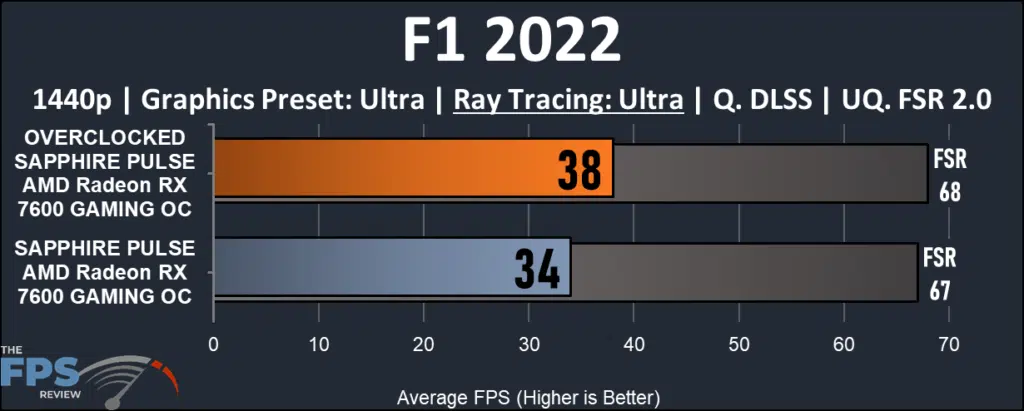
Given the plain raster performance at 1080p, we thought we’d turn up the resolution a notch to see how things would go. Keep in mind that AMD emphasizes that this video card is a 1080p performer. We looked at F1, Dying Light 2, and Cyberpunk 2077. The results were mixed but reflected the 1080p results pretty much. Without upscaling F1 was playable, Dying Light 2 marginal to playable, and Cyberpunk a fail. All three were better with FSR, and Cyberpunk reaching marginal levels. There was no hope for Ray Tracing.
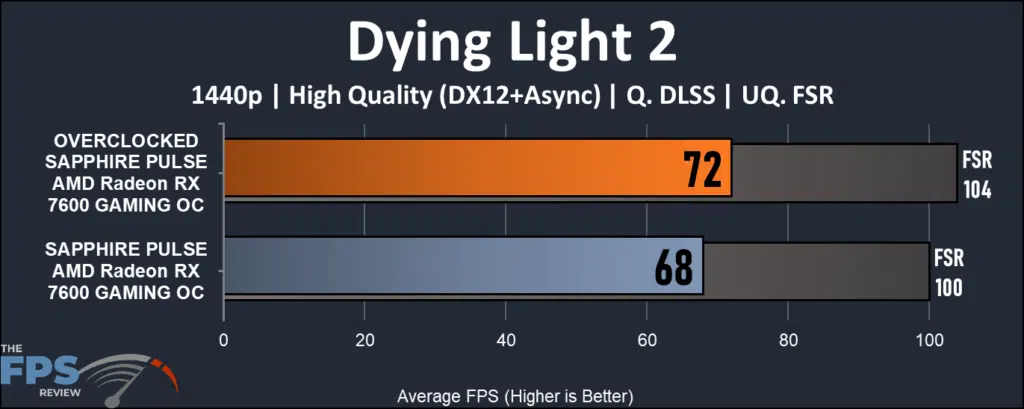
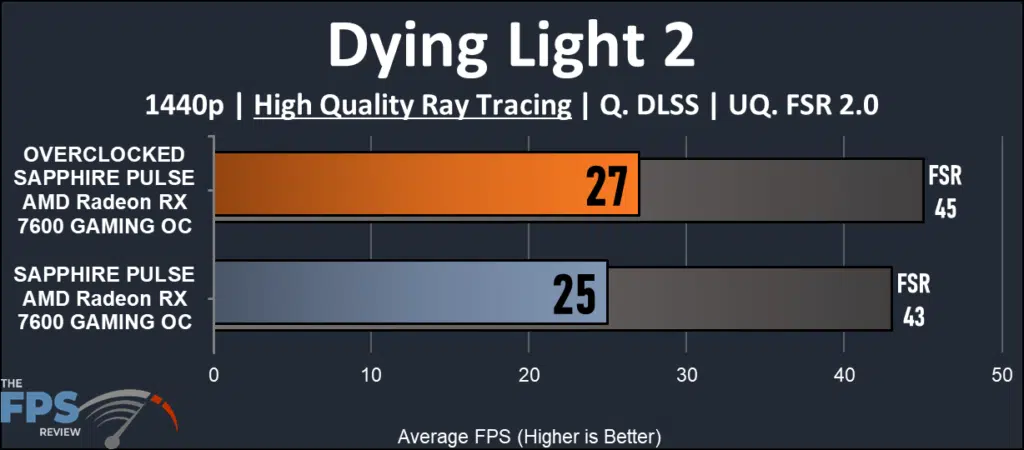
Keep in mind this was 1440p gaming at maximum settings…..so not really a wash-out. We’d say a more game-dependent experiment.
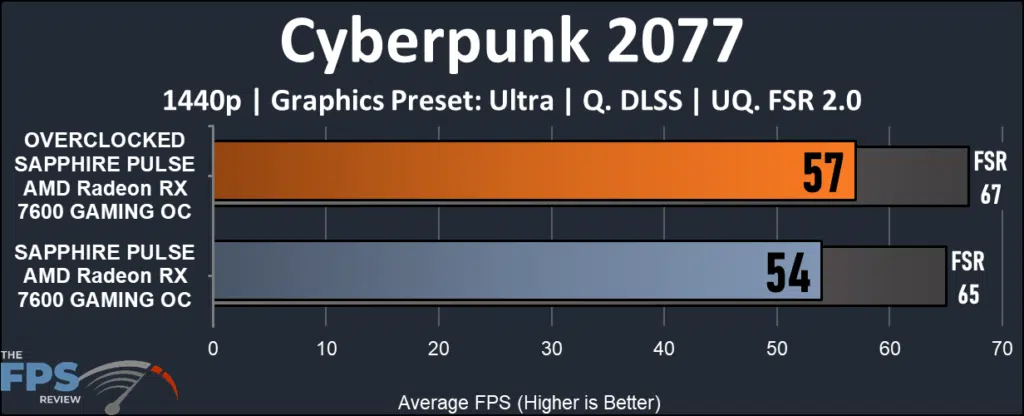
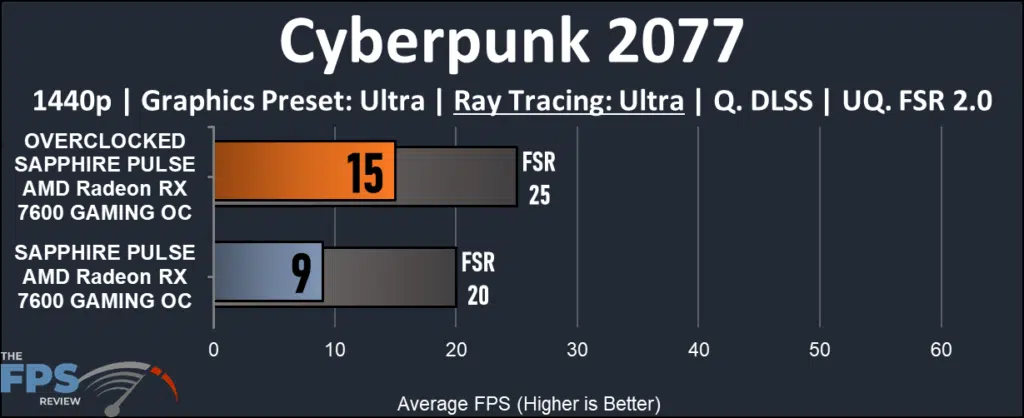
Overclocking
As was discussed in the overclocking section, overclocking was lackluster, to say the least. This is due to the baseline frequency being set at 2875MHz for this card and having the maximum setting in AMD Radeon software capped at 3000MHz. You simply have no headroom. The card performs very well at the capped frequency as we see on our charting, only rarely touching 3000MHz. In reality, the average clock in our benchmark run-throughs was 2875MHz without a single hiccup. This gain translated to about 3% in all the out-of-box settings, with the outlier being Modern Warfare II at 13%.
The cooling on this video card is more than adequate, even with the board pulling 211 watts when overclocked. The fans were never audible on this card on the open bench. We kept the default profile while overclocking and the fans never went over 49% at 64C on the GPU. We’d like to have some more room to see what this little card is capable of.
Final Points
SAPPHIRE has a nice video card in the PULSE AMD Radeon RX 7600 GAMING OC. The price is certainly refreshing, the performance is 25 to 30% better than the last generation and Ray Tracing is slowly improving. If you game at 1080p and want to see what things look like with all the graphics settings at their maximum, this is a good choice. I wouldn’t enable ultra Ray Tracing in every game, but some would work just fine in some games. You can also get 1440p gaming in as well if you pick and choose a little bit. This would also be an excellent SFF video card. SAPPHIRE is offering this video card at MSRP, with no price premium, so you are getting a custom-designed video card, with custom cooling that does a great job, and a factory overclock, with no premium. In our opinion, this card is worth a hard look.


